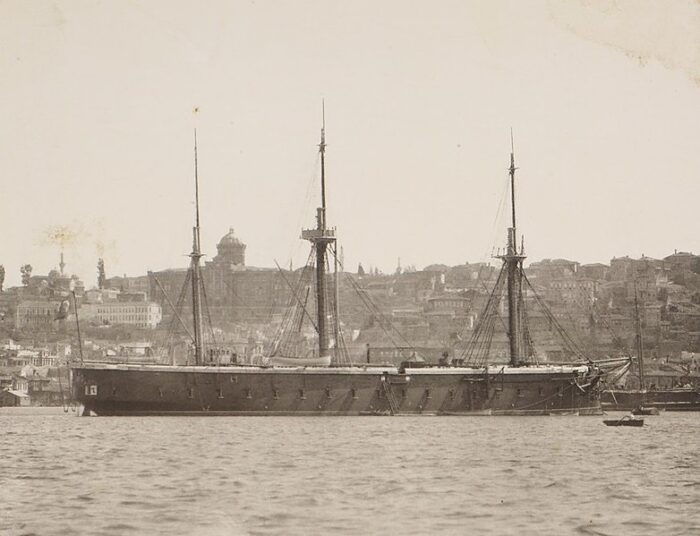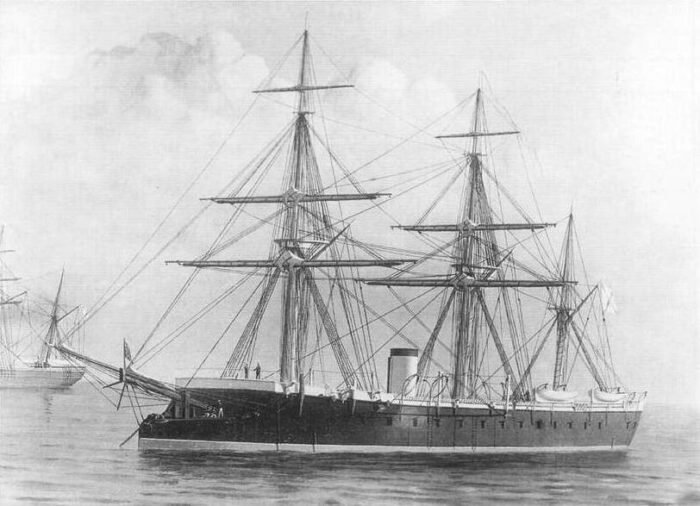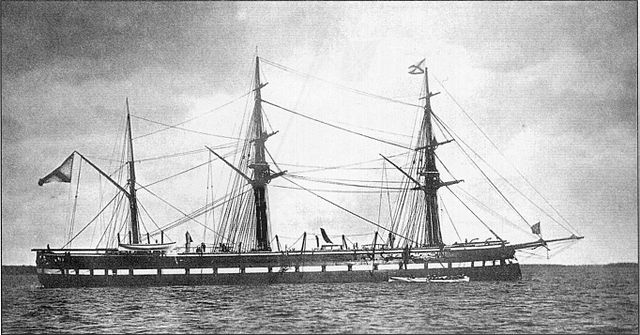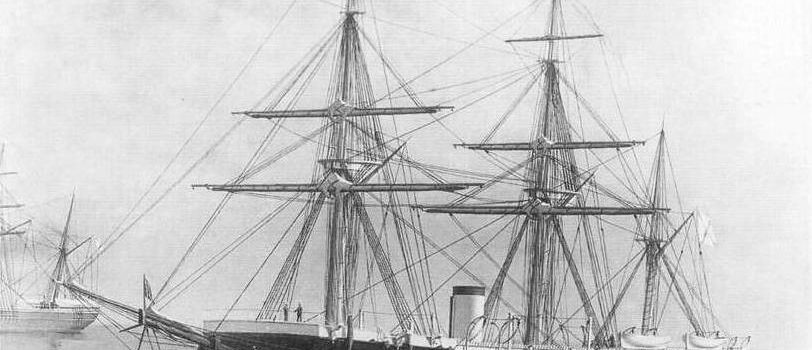 Imperial Russian Navy – Broadside Ironclad built 1860-65, in service until 1886.
Imperial Russian Navy – Broadside Ironclad built 1860-65, in service until 1886.
The Russian ironclad Sevastopol was ordered as a 58-gun wooden frigate by the Imperial Russian Navy in 1860 but converted while under construction into a 32-gun armored frigate. As the first armoured ship of the Russian Navy, she served in the Baltic Fleet, was reclassified as a training ship in 1880, decommissioned five years later and sold for BU in 1897. Russia was late in the game of ironclads, notably due having no need fore these. But in 1683 it became a good way to compensate for a clear inferiority in numbers on that chapter as the Ottoman Navy, supported against Russia by the west in the Crimean war, suddenly ordered four broadside ironclads to Britain, launched in 1864-65, the Osmanieh class. This was just the start. This is a new chapter here on naval encyclopedia, of the naval arms race between the Russians and Ottomans leading up to the 1877 Balkan war.
Development
An uneasy balance of power between two Empires
Before the decision to convert a frigate into a broadside ironclad, something that was done in many countries from 1859 (Gloire being such a conversion answered by the purpose built Warriors) was motivated by a serie of factors for Russia. As we saw in the Italo-Austrian naval arms race leading to the battle of Lissa in 1866, not all navies were eager to jump in the bandwagon of ironclads. Often, there was no immediate threat that could motivate such a move. The French had their arch-rival on the other side of the pond, despite warming relations (leading to the Crimean campaign), and Italy was in the process of its independence and reclaiming territories held by the Austrian, and later Austro-Hungarian Empire. Russia at that stage was a bit like the USA, a land power as qualified by Mahan, which most its nascent industries, populations and assets were in the west, up to the Urals. Beyond that was a great unknown populated by hostile nomads. So in a reverse of the move westwards in America, Russia started a move eastwards but also southwards.
Confined until Peter the Great to the Baltic, the foundation and original cradle of the Russian Navy, ambitions led to push towards the Black sea under Catherine the great, and consolidation. In the Baltic, Sweden was a clear opponent on the seas and land, following the Polish Commonwealth a century prior. With access to the Black sea, a similar move was done to transform Crimean into a hub of arsenals, fortified bases and ports. On this theater, the soon clear opponent was the Ottoman Empire, and this led to several clashes with strange turn of events due to fears about the balance of powers seen from the West.
Indeed, at Navarino, one of the major naval battles of the era, the Ottoman Empire faced a coalition of western navies, combined British, French, and Russian squadrons facing the battle fleet of admiral Amir Tahir. The coalition won a decisive victory on 20 Oct 1827, on the benefit of Greek insurgents. However aft this, the decline of the Ottoman Empire saw a greater appetite from the Russians towards the Balkans and in the black sea. At the Battle of Sinop in 1853, Russian ships attacked and annihilated the Turkish fleet, notably using their Paixhans explosive shell guns. This led to the west taking side of their former opponent in 1855 for the Crimean war. This only urged the need for the Russian Navy to find ways, not to compete with the West directly (Neither the finances not the industry were there to ensure such a growth) but at least try to contain and if possible defeat again the Ottomans. This led to an arms race between the two, and led to a third chapter, a direct and massive confrontation, the Russo-Ottoman war of 1877-78, soon after Sultan Abdul Amid came to power and decided to stop the shipbuilding program and refocus on the land army.
Respective fleets in 1860
The respite offered to the Ottomans by the Crimean war enabled time to restore a small fleet albeit the Sultan in 1860 counted on the support of the Royal Navy in the Mediterranean. In fact there was little incentive to develop the fleet further, at least until Sultan Abdul Aziz decided to undertake a program of ironclads. At that stage, the Ottoman Navy had 7 line of battle ships, 6 frigates, 4 corvettes and 9 smaller vessels, bricks and dispatch vessels. In 1863 Abdul Aziz decided to order four 6400t broadside Ironclads to Britain, three in Napier and one at Thames iron Wks, the Osmanieh class (referring to Osman, the founder of the Turkish Empire). Until then, the Russian Navy counted five screw (steam powered) 131-guns 1st rank man-o-war, six screw 2-decker 1st rank vessels, nine large screw frigates, 18 screw corvettes and eight screw sloops. They, in addition, all used deck mortars to fire Paixhans bombs. The Russians, even in the Back sea, seems to have a clear advantage, but they lacked any Ironclad. This led to the construction of the Osmanieh, soon known by the Russians through the Russian naval attaché in London.
The naval arms race

Turkish Ironclad Omanhiye in the Golden Horn
Thus, this led to the decision of converting two sister ships, new frigates from the Baltic fleet as there was no facility yet in Crimea to start building such ships. Next were the three Pervenetz class (the prototype was built in UK), completed 1865, regaining some advantage, and the central battery Kniaz Pojarski in 1970, then the Minin in 1869, as well as a serie of coastal vessels, the Bronenosetz class monitors, the 1865 turret ironclad Smerch, the two Charodieka, Admiral Lazarev and Chichagov, the famous Novorod and popov in 1874 (complete date each time) and the first all steam modern turret battleship, Petr veliki in 1876, prior to the war with the Ottomans. Next after a long pause or nearly ten years, were the black sea fleet Ekaterina class barbette ships we just saw.
Meanwile the Turks ordered in France barbette ironclads, Assari Tewfik class (La Seyne, comp. 3 ships launched 1868) and coast defence turret ships of the Lufti Djelil class the same year followed by the British ordered Avni Illah class casemate ironclads, launched 1869, the two Fethi Bulend class (with Mukhaddami Khair built in Constantinople) launched 1870-71, on in Italy, the barbette ironclad Idjalieh, launched 1870, the two massive Messoudieh in britain (launched 1874-75) before the new Sultan in 1876 decided to “pull the plug” of these programs.
Design of the class
The Sevastopol and Petropavlovsk are often separated by some authors (that’s the case for Conways) and united for others. For the sake of convenience, they will be seen as a single class here, as they were originally sister ships, had the same basic specs but ended quite different due to their respective yards, Kronstadt and New Admiralty. Both were indeed originally specified and ordered as 58-gun wooden steam frigates as improvements on the 4,500t Nevski class (launched 1861, 51 guns).
Hull and general design
Sevastopol measured 300 feet (91.4 m) after conversion between perpendiculars, for a beam of 50 feet 4 inches (15.3 m), draft of 22 feet 2 inches (6.8 m) forward and 24 feet (7.3 m) aft. She displaced 6,135 long tons (6,233 t). Both ships had a blunt iron ram at their bow. She had a crew of 607 officers and enlisted men. Petropavlovsk was identical in dimensions but displaced 6,040 long tons (6,140 t). Both were considered to be seaworthy. Her crew wa slarger however to armament’s differences and amounted to 680 officers and enlisted men.
Design wise they were typical of the time, with a battery deck, and a flush deck protected by tal bulwarks all along, a single funnel preceded by a bridge with wings running on both sides.
As shown in photos they diverged also in style. Sevastopol had an all-black hull whereas Petropavlovsk had a white battery line with black ports (many fake outside the central ones).
Protection
Both ships were protected the same way, with wrought-iron armor plates (ordered in Britain). They extended 5 feet 2 inches (1.6 m) below the waterline while being 4.5 inches (114 mm) thick amidships. As often at the time, the were backed by 10 inches (254 mm) of teak, thinned on both ends to 3 inches (76 mm) wrought iron, and then backed again by six inches of teak in steps from 50 feet (15.2 m) of both ends, which were left unprotected. They had no armoured deck nor conning tower.
Powerplant
Both were fitted with the same powerplant, an horizontal return-connecting-rod steam engine (HRCR) built by Izhora Works of Saint Petersburg. It could drive a single two-bladed propeller fed by a number of rectangular boilers, possibly six. In sea trials, Sevastopol’s engine produced 3,088 indicated horsepower (2,303 kW) for a top speed of 13.95 knots (25.84 km/h; 16.05 mph). She carried 400 long tons (410 t) of coal and like her sister she was schooner-rigged with three masts.
Her sister Petropavlovsk had a the same engine but driving a four-bladed propeller and in sea trials, her engien produced 2,805 indicated horsepower (2,092 kW) for a top speed of 11.8 knots (21.9 km/h; 13.6 mph). She also carried less coal than her sister at 375 long tons (381 t). Range in unknown for both.
Armament
Both were designed as 1st ranke “heavy” frigates and initially were better armed than the Donskoi class with 54 heavy SBLs. These were 7.72-inch (196 mm) 60-pounder smoothbore guns completed by four long 36-pounder smoothbores. When armoured it was revised and reduced to thirty-two 60-pounder guns: Four on the upper deck (chase guns) and 28 on the lower deck, main battery. In 1868, one chase gun and two lower deck guns were replaced by more modern 8-inch (203 mm) rifled guns, then 11 more 60-pounders replaced by seven 8-inch guns in 1870. In 1877, they Sevastopol had 14 eight-inch guns on the lower deck, two on the upper deck with large traversing mounts and a single 6-inch (152 mm), ten 3.4-inch (86 mm) rifled guns to round this up.
For Petropavlovsk, she was revised to twenty 8-inch (203 mm) rifled guns, two 60-pounder guns between the lower deck and upper deck, mounted as chase guns respectively. In 1868 they had another pair of 60-pounder on the upper deck. In 1877 they had a 8-inch, a 6-inch (152 mm) and ten 3.4-inch (86 mm) rifled guns mounted on the upper deck.
⚙ specifications (*Petropavlovsk) |
|
| Displacement | 6,275 long tons (6,376 t) *6,040 long tons (6,137 t) |
| Dimensions | 300 ft x 50 ft 4 in x 24 ft (91.4 x 15.3 x 7.3 m) |
| Propulsion | HRCR engine, c6 rec. boilers 3,090 ihp (2,300 kW)/*2,805 ihp (2,092 kW) |
| Speed | 13 knots (24 km/h; 15 mph) *11.85 knots |
| Range | Unknown, unlimited with sail |
| Armament | 32× 60-pdr smoothbore guns initially |
| Protection | Belt 3–4.5 in (76–114 mm), Battery 4.5 in (114 mm) |
| Sensors | |
| Air Group | |
| Crew | 607 *680 |
Career of the Sevastopol class
On June 3, 1860, a contract was signed between the Naval Ministry of the Russian Empire and S. G. Kudryavtsev for the construction of a 59-gun frigate in Kronstadt, launched on October 15, 1862. The frigate was started on September 7, 1860, and on September 19, a contract was signed for the construction of a second armored frigate in the New Admiralty, named “Petropavlovsk”.
The ceremonial keel laying took place on March 16, 1861 in the Northern “Petrovsky” dock of Kronstadt supervised by chief builder of the ship of the Corps of Naval Engineers (KKI), Colonel A. Kh. Shaunburg, in presence of Grand Duke Konstantin Nikolaevich. The second hull was laid on September 9, 1861, under the supervision of the ship’s builder KKI Captain A. A. Ivaschenko in the presence of the head of the Naval Ministry Admiral N. K. Krabbe.
In 1862, Rear Admiral S. S. Lesovsky presented a plan to convert two ships under construction into armored coastal defense batteries, but it was rejected after being reviewed by the Naval Ministry. Chief shipbuilders A. H. Schaunburg and A. A. Ivaschenko were sent to Britain and France meanwhile to learn about armored ships construction along and by October 16, 1863, Sevastopol’s hull was moved to theSouthern Dock of Kronstadt for further completion and conversion. Since the builders were independently adjusted drawings to meet new requirements, both ships diverged and ended as near sisters.
 Sevastopol (1864)
Sevastopol (1864)

On August 12, 1864, at 1 o’clock in the afternoon, Sevastopol under command of Captain F. Ya. Brummer, sailed out of the Southern Dock of Kronstadt and moored at the arsenal for fitting out. The team-powered capstans came from Britain and were installed, with the last two upper parts of the bow ram adjusted. On October 8, she left the harbor for initial yard trials, managing to reach 9.5 knots with the steam pressure of 12-14 pounds. On July 8, 1865, she made officials trials in front of the Shipbuilding Technical Committee, tested without her ram. Se managed to reach 13.966 knots, out of 3380 indicated hp, for a displacement of 5,910 tons. She was then accepted into the treasury, and enlisted in the Baltic Fleet in 1865 with a total cost of 1,669,356 rubles.
In 1865, she made a training and shakedown cruiser in the Baltic Sea to Stockholm and Copenhagen as flagship. In July 1866 she was part of a squadron under Rear Admiral Likhachev also comprising the battery Ne tron menya, the frigates Dmitry Donskoy, Khrabry, Vladimir, clipper Yakhont, and turret ship Smerch plus four Bronenosetz class monitors to Helsingfors, meet the USN, monitor Miantonomoh and steamship Augusta under Captain G. F. Fox, assistant secretary of the Navy, bringing their embassy to Russia. The Russian squadron escorted them to the Great Kronstadt Roadstead.
In August-September 1866 the squadron was at the Transund Roadstead, reviewed by the Naval Ministry and the ships, including Sevastopol, made a fire dsmonstration. Sevastopol fired 56 shots underway at 2.5 to 5 knots on target 5-7 cables away, 39 shots from her 60-pounder guns, 17 shots from her deck 8-inch rifled guns. The target measured 50×20 feet and she made 25 hits. She won the third prize for accuracy. In the 1870s, she was deployed in yealy manoeuver with the squadron of the Baltic Fleet and in 1873 under command of CaptainP. A. Selivanov she departed with midshipmen and cadets for a Baltic Sea cruise.
In 1875-1876, Sevastopol and Vladimir sailed under Captain 1st Rank G. N. Zabudsky in the Finnish skerries with the Baltic Sea HQ staff.
Sevastopol was disarmed in the summer of 1877 but due to the war ongoing, kept in reserve until the summer of 1886. On October 11, 1886 between the general state of her wooden hull and obsolecnece, she was stricken and by May 1887, sold for scrap.
 Sevastopol (1864)
Sevastopol (1864)

Petropavlovsk, named the siege during the Crimean War, was laid down on 12 January 1861 at New Admiralty Shipyard, Saint Petersburg, reordered and converted into a 22-gun armored frigate on 29 October 1861 while still under construction. Launched on 15 August 1865, commissioned on 1 August 1867 she served as the flagship of the Baltic Fleet alonsgide Sevastopol. On 15 August 1869, she took part in a fleet exercise off Hogland with Kreml, Oleg, Pervenets and Vityaz when Kreml rammed Oleg and sank with 16 of her crew. Petropavlovsk rescued some. On 13 September 1871, she collided with the merchant ship Damrowsky off Reval. In September, she collided with the British merchant Ecliptic. She was eventually decommissioned on 15 June 1885, like her sister already in reserve due to her age and condition, and finally she was stricken on 4 January 1892 and sold for scrap.
Read More/Src
Books
Chesneau, Roger & Kolesnik, Eugene M., eds. (1979). Conway’s All the World’s Fighting Ships 1860–1905. Greenwich, UK: Conway Maritime Press.
“Russian Ironclad Frigates Sevastopol and Petropavlovsk”. Warship International. VII (4)
Silverstone, Paul H. (1984). Directory of the World’s Capital Ships. New York: Hippocrene Books.
Treadea, John; Sozaev, Eduard (2010). Russian Warships in the Age of Sail, 1696–1860: Design, Construction, Careers and Fates. Seaforth Publishing..
Watts, Anthony J. (1990). The Imperial Russian Navy. London: Arms and Armour.
Links
keu-ocr.narod.ru
on ru.wikipedia.org/
on en.wikipedia.org
Model Kits
None


 Latest Facebook Entry -
Latest Facebook Entry -  X(Tweeter) Naval Encyclopedia's deck archive
X(Tweeter) Naval Encyclopedia's deck archive Instagram (@navalencyc)
Instagram (@navalencyc)





 French Navy
French Navy Royal Navy
Royal Navy Russian Navy
Russian Navy Armada Espanola
Armada Espanola Austrian Navy
Austrian Navy K.u.K. Kriegsmarine
K.u.K. Kriegsmarine Dansk Marine
Dansk Marine Nautiko Hellenon
Nautiko Hellenon Koninklije Marine 1870
Koninklije Marine 1870 Marinha do Brasil
Marinha do Brasil Osmanlı Donanması
Osmanlı Donanması Marina Do Peru
Marina Do Peru Marinha do Portugal
Marinha do Portugal Regia Marina 1870
Regia Marina 1870 Nihhon Kaigun 1870
Nihhon Kaigun 1870 Preußische Marine 1870
Preußische Marine 1870 Russkiy Flot 1870
Russkiy Flot 1870 Svenska marinen
Svenska marinen Søværnet
Søværnet Union Navy
Union Navy Confederate Navy
Confederate Navy Armada de Argentina
Armada de Argentina Imperial Chinese Navy
Imperial Chinese Navy Marinha do Portugal
Marinha do Portugal Mexico
Mexico Kaiserliche Marine
Kaiserliche Marine 1898 US Navy
1898 US Navy Sovietskiy Flot
Sovietskiy Flot Royal Canadian Navy
Royal Canadian Navy Royal Australian Navy
Royal Australian Navy RNZN Fleet
RNZN Fleet Chinese Navy 1937
Chinese Navy 1937 Kriegsmarine
Kriegsmarine Chilean Navy
Chilean Navy Danish Navy
Danish Navy Finnish Navy
Finnish Navy Hellenic Navy
Hellenic Navy Polish Navy
Polish Navy Romanian Navy
Romanian Navy Turkish Navy
Turkish Navy Royal Yugoslav Navy
Royal Yugoslav Navy Royal Thai Navy
Royal Thai Navy Minor Navies
Minor Navies Albania
Albania Austria
Austria Belgium
Belgium Columbia
Columbia Costa Rica
Costa Rica Cuba
Cuba Czechoslovakia
Czechoslovakia Dominican Republic
Dominican Republic Haiti
Haiti Hungary
Hungary Honduras
Honduras Estonia
Estonia Iceland
Iceland Eire
Eire Equador
Equador Iran
Iran Iraq
Iraq Latvia
Latvia Liberia
Liberia Lithuania
Lithuania Mandchukuo
Mandchukuo Morocco
Morocco Nicaragua
Nicaragua Persia
Persia San Salvador
San Salvador Sarawak
Sarawak Uruguay
Uruguay Venezuela
Venezuela Zanzibar
Zanzibar Warsaw Pact Navies
Warsaw Pact Navies Bulgaria
Bulgaria Hungary
Hungary

 Bundesmarine
Bundesmarine Dutch Navy
Dutch Navy Hellenic Navy
Hellenic Navy Marina Militare
Marina Militare Yugoslav Navy
Yugoslav Navy Chinese Navy
Chinese Navy Indian Navy
Indian Navy Indonesian Navy
Indonesian Navy JMSDF
JMSDF North Korean Navy
North Korean Navy Pakistani Navy
Pakistani Navy Philippines Navy
Philippines Navy ROKN
ROKN Rep. of Singapore Navy
Rep. of Singapore Navy Taiwanese Navy
Taiwanese Navy IDF Navy
IDF Navy Saudi Navy
Saudi Navy Royal New Zealand Navy
Royal New Zealand Navy Egyptian Navy
Egyptian Navy South African Navy
South African Navy






























 Ukrainian Navy
Ukrainian Navy dbodesign
dbodesign